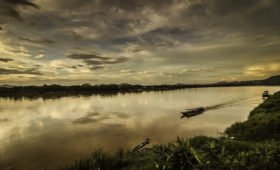HA means to descend or land; LONG means Dragon.
Halong Bay has been UNESCO World Natural Heritage listed since 1994.
Words alone cannot describe one of the most uniquely beautiful places on earth. A fairly long history has Halong Bay as it was created around 300 million years ago.
The Bay is 165 kilometres from the capital Hanoi and covers an area of 43,400 hectares. There are over 1,600 islands and inlets mostly uninhabited and untouched by human hands all created by one of two theories.
Geology; Mother Nature
Karst landforms are generally the result of mildly acidic water containing carbonic acid that begins to dissolve the surface along cracks or bedding planes. Over time, these fractures enlarge as the bedrock continues to dissolve. Openings in the rock increase in size and an underground drainage system begin to develop, allowing more water to pass through the area, and accelerating the formation of underground karst features.
Marine erosion has played a factor during its geological timescale. Repeated rising and falling of sea level, called regression and transgression, is when an area is covered by seawater, then dries up; rinse and repeat, so to speak. Currently, it is why one can see erosion at the bottom of the islands and pinnacles, hence some appear to be top-heavy, balancing precariously as the salty sea water cuts through systems of cracks and fractures.
The Legend
Legend has it that shortly after the formation of the country, Vietnamese people had to fight back against hostile invaders attempting to enter the country through the sea. Refusing to allow his people to be defeated, the revered Jade Emperor called upon the Gods to send the Mother Dragon and her children to help the Vietnamese people in defeating their enemies.
The Mother Dragon and her children did not hesitate, they heeded the Emperor’s call and ferociously came down on to face the attackers. Although the invaders were powerful and on the verge of winning, the dragons destroyed them in a blaze of fire.
As the enemy was defeated, giant emeralds appeared and scattered along the bay. According to legend, these emeralds were actually the teeth of the Mother Dragon and her children. The emeralds were left behind to create an impossible-to-penetrate barrier to discourage any future invasions. Peace returned to the country and after a thousand years, these walls of emeralds transformed into the islands and islets that you can admire in Halong Bay today.
After their triumph in Halong Bay, the Mother Dragon and her children never returned to the heavens from which they were summoned. Instead, they stayed and adopted the form of humans to help the Vietnamese people farm, raise cattle, reclaim land and thrive. To commemorate the intervention of the Mother Dragon and her children, Vietnamese people named the bay: “Hạ Long” and the area where her children landed, “Bái Tử Long”; the latter meaning “Bowing down and showing respect to the dragon’s children”.
Halong Bay Today
Whatever theory you believe in you can experience it today as it was when the dragon was around.
An interesting bus drive from Hanoi to Halong City before we board our deluxe boat for some pure relaxation time.
Sit back, grab a cold drink on the deck and take it all in. An afternoon doesn’t get much better than this. For dinner sup on seafood and that extra relaxer if you desire before retiring to your lovely en-suite deluxe cabin for the night. Not a care in the world.
After breakfast the next morning there is more scenic relaxation before either returning to Halong City for an afternoon return to Hanoi or possibly getting dropped off on Cat Ba Island for a night there before returning to Hanoi the following day. Can you imagine how good it is sipping your fav drink on the deck as this magnificence passes by?
Book this 10-day tour to North Vietnam and you will also visit the Halong Bay of the rice paddies in Tam Coc and the no less spectacular but lesser know mountain scenery of Sapa. Make your own memorable history of Halong Bay.




